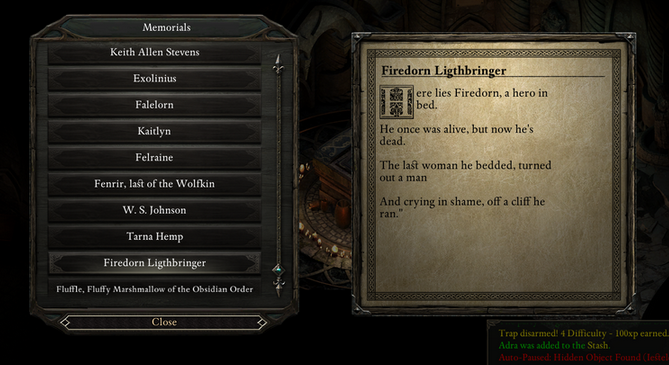At a party a few weeks ago, I ran into a guy who was in UCSD’s undergraduate literature/writing program at the same time I was, and, in the course of our conversation that evening, we found ourselves eventually turning from the typical small talk (Hi! How are you? What are you up to these days?) and turning to the topic of video games. And this happened because, after explaining that my current research interests as a graduate student in the field of literature include the consideration of video games as contemporary narratives, my fellow UCSD alum asked me if I really consider video games to be a “high art form.”
There is a lot to unpack in this question. It’s a loaded one. And it’s one that, for me, brings up even more questions—such as what is it that allows one art form to be a product of high culture while another is classified as a low art form? Who gets to say which form is high culture and which one is low? Who, if anyone, could be said to have any right to police such designations? And further, since such a question seems to imply that only “high art forms” are appropriate or legitimate ones to be explored within academia, what is it about the arena of the university—and, specifically, the university’s literature department—that causes people to include certain forms (read: the high ones) as valid for academic study and exclude others due to some sort of perceived illegitimacy? How do we navigate such cultural and textual systems of inclusion and exclusion, and how do we, if at all possible, (re)imagine our texts and our art outside of such hierarchies?
 It seems to me that video games are often, or at least are lately, the specific form around which such questions are framed. And not just at parties. Indeed, the gaming community itself seems to be asking similar questions regarding the artistic and narrative potential of the games that we play. For instance, it is this narrative potential that Leigh Alexander says makes people excited about games, but, as she goes on to say, it is a potential that rarely seems to be fully realized: “People often say they are enthusiastic about games because ‘they can tell stories’, or because they enable narrative moments not possible in other media. But although there are numerous flashes of brilliance in games, this potential often feels like something they circle, but never attain.” As such, Alexander finds narrative and gameplay generally to be “at cross-purposes, feeling like separate entities where one gets in the way of the other at best, and they defeat one another in the worst case.”
It seems to me that video games are often, or at least are lately, the specific form around which such questions are framed. And not just at parties. Indeed, the gaming community itself seems to be asking similar questions regarding the artistic and narrative potential of the games that we play. For instance, it is this narrative potential that Leigh Alexander says makes people excited about games, but, as she goes on to say, it is a potential that rarely seems to be fully realized: “People often say they are enthusiastic about games because ‘they can tell stories’, or because they enable narrative moments not possible in other media. But although there are numerous flashes of brilliance in games, this potential often feels like something they circle, but never attain.” As such, Alexander finds narrative and gameplay generally to be “at cross-purposes, feeling like separate entities where one gets in the way of the other at best, and they defeat one another in the worst case.”
Will O’Neill, too, in seeking to explain how one might write a more compelling game narrative, seems to reside in Alexander’s camp regarding the current state of game narratives, for he argues, “People buy games because of ‘the story’, but a quick look at global Steam achievements will also tell you that the vast majority of said people never get anywhere close to the end of them.” So, according to the line of thinking established by Alexander, O’Neill, and others (both within and without the gaming community), it would appear that many people see video games as an exciting creative form, one that, perhaps, has not wholly achieved its narrative, artistic potential.
Ian Bogost claims that the main thing that may be preventing games from realizing this potential are the characters—in other words, our proclivity to create (and desire) individual narratives, individual storylines, and individual characters gets in the way of what Bogost believes to be games’ true potential, which is, as he believes, the ability to represent larger systems; or, as he asks, “Why must we have characters in games at all? Or, more gently put, why have we assumed that the only or primary path to video-game diversity and sophistication lies in its representation of individuals as opposed to systems and circumstances? In truth, we’ve all but abandoned the work of systems and behaviors in favor of the work of individuals and feelings. And perhaps this is a grievous mistake.” And Bogost finds this to be a mistake because, ultimately, he believes that video games operate differently than other narrative media forms:
Other narrative media succeed more often and more profoundly at producing identification and empathy with individuals of our own creed, color, gender, and sexual identification—or with those of other identifications. Sure, film and literature and television also have problems with representation, but their character-driven narratives match well to their forms. Yet, alas, at their best, game characters and game stories are still mostly like bad books and films and television, but with button pressing. Perhaps the only reason not to let these other media do the work they do best is if we fancy games a world unto itself, a private media ecosystem.
But, as Ben Gabriel points out, the problem with Bogost’s desire for video games to become a “private media ecosystem” entirely removed from seemingly more traditional narrative representation is that such a belief is an exercise in “utopian idealism. Idealism because it fixates on the content of the thing, rather than the practices it may provoke; utopian because it wants these things to be seen and therefore become true, rather than struggled for.” And such utopian idealism does not take into account the fact that larger systems tell stories too—that there is narrative potential in even the (seemingly) simplest game, and that this potential should be struggled for. And it seems to me that it is this potential that also causes those like Alexander and O’Neill to struggle for improvement in the manner in which games continue to tell stories.
So, if video games tell stories, and if they do so in an imperfect way, does that make them a product of low culture? Or, to return to my colleague’s original phrasing in the question he posed at the party, does that exclude games from the possibility of being considered to be a high art form?
 I guess my question is this—why does it matter? Why does it matter if video games are high or low art? Why do we feel the need to categorize our artistic and cultural forms in these ways? Why do we feel the need to legitimize—and, conversely, delegitimize—our artistic and cultural products through such designations? To do so seems exclusionary and limiting, for if we discount video games as a flawed product of low culture, then we limit ourselves in our ability to explore their full narrative and artistic potential, and we limit ourselves in our ability to explore what it is such modes of storytelling and representation have to offer us in the way we think about how it is we interact with a text and what such interactions might tell us about ourselves.
I guess my question is this—why does it matter? Why does it matter if video games are high or low art? Why do we feel the need to categorize our artistic and cultural forms in these ways? Why do we feel the need to legitimize—and, conversely, delegitimize—our artistic and cultural products through such designations? To do so seems exclusionary and limiting, for if we discount video games as a flawed product of low culture, then we limit ourselves in our ability to explore their full narrative and artistic potential, and we limit ourselves in our ability to explore what it is such modes of storytelling and representation have to offer us in the way we think about how it is we interact with a text and what such interactions might tell us about ourselves.
It is this potential for exploration that, of course, makes video games ripe for academic study (which is why game studies is a thing). But it often seems that such study seeks to legitimize itself by embarking on a similar method of exclusionary categorization, such as the ludological desire to distinguish video games as a media form entirely separate from other forms—something that Bogost seems to do when he argues for the removal of characters and individual narratives from games. But these hierarchies and demarcations and bifurcations distract us from the fact that we tell stories. We tell stories in so many different ways. We tell stories in films and novels and comic books and video games, from Beowulf to Life is Strange. It doesn’t seem fair to ask why or if one story is more important or valid than the other. It seems elitist to think that we can. It seems more productive and engaging, at least to me, to think about why we’re telling these stories in these ways and to think about whose stories are being told.
 I guess this is why (or at least one of the reasons why) I, as someone working in the field of literature, want to explore video games as contemporary forms of narrative and artistic expression. And I guess that’s why I hope that literature departments might begin to embrace such narratives as well—for if we don’t allow our academic and literary study to evolve alongside the types of stories that are being told, then we are severely limiting ourselves in what we might accomplish and explore within our field. Because if, as Alexander says, “[w]ell-written games are a dialogue with the player,” then perhaps it is also important for well-functioning academic fields to engage in a dialogue with games.
I guess this is why (or at least one of the reasons why) I, as someone working in the field of literature, want to explore video games as contemporary forms of narrative and artistic expression. And I guess that’s why I hope that literature departments might begin to embrace such narratives as well—for if we don’t allow our academic and literary study to evolve alongside the types of stories that are being told, then we are severely limiting ourselves in what we might accomplish and explore within our field. Because if, as Alexander says, “[w]ell-written games are a dialogue with the player,” then perhaps it is also important for well-functioning academic fields to engage in a dialogue with games.




